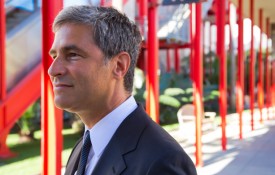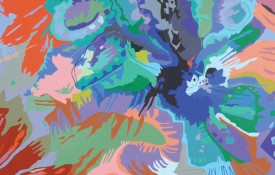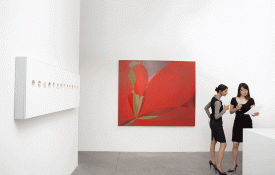Celebrating LACMA’s First 50 Years
{Miracle Mile} Los Angeles County Museum of Art
In honor of LACMA’s 50th anniversary, two philanthropy power couples – Stewart and Lynda Resnick and Marc and Jane Nathanson – have gifted the museum with eight influential works that cover a spectrum of styles and periods. The donated works, created by a palette of artists including Jean-Auguste Dominique Ingres, Roy Lichtenstein, Hans Memling, and Andy Warhol, will be on display beginning April 26 in LACMA’s 50 for 50: Gifts on the Occasion of LACMA’s Anniversary exhibit. Running through September 7, the exhibit will feature an additional 42 pieces promised by the two families. The 50 pieces will be officially announced and unveiled for the first time at LACMA’s Anniversary Gala on April 18. LACMA members will be privy to an exclusive viewing April 20–25. The pieces will also be on display for a free community day on the official opening of the exhibition. The donated works are a celebrated addition to the more than 120,000 works in the museum’s collection.
lacma.org

Artwork: “Portraits of the Scull Family” by James Rosenquist
Leaders in the Arts
{Los Angeles} The Blue Ribbon, Dorothy Chandler Pavilion
It’s a rarity that the leaders of LA’s major arts institutions turn up en masse to share their thoughts on the local complexion of their industry. In March, Michael Govan (LACMA), Dr. Steven Koblik (Huntington Library), Ann Philbin (Hammer Museum), Dr. Timothy Potts (J. Paul Getty Museum), and Philippe Vergne (MOCA), were joined by moderator Earl Powell III (National Gallery of Art) at Dorothy Chandler Pavilion for a special panel, organized by The Blue Ribbon, the premier women’s support organization of The Music Center. The group addressed the subject of diversity – in the arts as well as among patrons – as well as digital advances and how each institution is staying relevant and planning for the future. As the average age of a paper manuscript housed at Huntington Library is 300 years old, one shared area of concern is the digital archiving of paper documents. “It’s very difficult to imagine that the documents that we digitally format today will exist in that form – 25, 50 years from now,” said Koblik. Among other pieces of insight: Installations targeting diversity impact the demographics. The Huntington opened its Chinese Garden in 2008; of its 36,000 members, 20 percent are Chinese.

From left to right, Dr. Steven S. Koblik (President, The Huntington Library),
Philippe Vergne (Director, MOCA), Ann Philbin (Director, Hammer Museum), Carla Sands (President, The Blue Ribbon), Dr. Timothy Potts (Director, J. Paul Getty Museum), Earl A. Powell III (Director, National Gallery of Art), Michael Govan (CEO and Wallis Annenberg Director, LACMA)
Photo: John McCoy
In Focus: Play
{Los Angeles} The Getty Center
When photography was introduced in 1839, it coincided with the end of the Industrial Revolution, which had sparked social and economic changes in America. Over the following year, as the culture of leisure began to flourish and the popularity of the camera grew, it marked a turning point in documentation as people started to capture their everyday life in addition to the monumental and historical events photography was previously reserved for. The new medium was used to record dancing and swimming with the same simplicity and ease as quiet contemplation. The exhibition In Focus: Play at The Getty features the enthusiastic development of playful photography with works by artists such as Roger Fenton, Bill Owens, Larry Sultan, and many others. Open until May 10, the exhibit follows the progression of photography style from its origin to the present day, tracing the introduction of color photography, faster film, and handheld cameras as they were introduced into the pre-selfie culture.
getty.edu

Petersen Goes to the Library
{Simi Valley} Ronald Reagan Presidential Library
The first of a three-part Amazing Automobiles: The Ultimate Car Exhibit is currently on display at the Reagan Library, courtesy of the Petersen Automotive Museum. Thirteen of Petersen’s most memorable cars, many from their vault and not regularly seen by museum-goers, will be on display until May 1. With models ranging from 1913 to 2001, this installation has something for every generation. Elvis Presley’s iconic 1971 DeTomaso Pantera, which still has three bullet holes from the day he shot the car, is just one of the cars being displayed. The 1998 Cadillac Papal Parade Phaeton owned by Pope John Paul II will also be featured as part of the exclusive exhibit. And let’s not forget the 1913 Mercer Raceabout, considered by many to be the first racecar. Renovations at the Petersen Museum’s permanent home are scheduled to be complete in December.
regeanfoundation.org

Provocations: The Architecture and Design of Heatherwick Studio
{Westwood} The Hammer Museum
Designer of an impressive array of buildings, British national Thomas Heatherwick constructed the Olympic Cauldron for the 2012 Summer Olympics in London. Of his large projects in the U.K., U.S., Abu Dhabi, South Africa, Singapore, and China, Heatherwick’s most renowned work is the Seed Cathedral, constructed in Shanghai, where it stood for the six-month 2010 World Expo. The structure won the BIE Gold Award for the best pavilion design. The Seed Cathedral has since been dismantled and donated to schools, charities, and the World Expo Museum. The exhibition, made possible by Burberry, will also feature a lecture talk with Heatherwick himself on April 30.
hammer.ucla.edu

Masterpieces Trading Places
{Pasadena} Norton Simon Museum
A peek at the masterpieces of the Musée d’Orsay no longer requires a ticket to Paris and a day on the plane. For this spring only, the Musée d’Orsay and Norton Simon Museum have agreed to trade three of their most prized pieces of artwork. One of the three that will be on display at Norton Simon until June 22 is a work by James Abbott McNeill Whistler, often considered his most recognizable and most popular piece, the portrait of his mother painted in 1871 at the height of his artistic expression. Joining Whistler’s piece are Édouard Manet’s famed painting of his friend and collaborator, literary artist Émile Zola, as well as Paul Cézanne’s renowned Card Players. While the three pieces are displayed in Pasadena, Norton Simon has sent Paris three pieces of their own collection from the mid- and late-1800s from the great artists Vincent van Gogh, Pierre-Auguste Renoir, and Édouard Vuillard.
nortonsimon.org

Out of the Limelight: Little-known yet much-loved, these LA spots are worth seeking out
The Japanese Garden
Van Nuys
An indirect product of the 1965 Federal Water Quality Act, the Japanese Garden offers hope that zen tranquility can emanate from legislation that tackled inefficient municipal sewage disposal systems. Designed in 1970 by Dr. Koichi Kawana (who also designed the Japanese Friendship Garden in San Diego’s Balboa Park), the site officially opened in June 1984. Located next to the Donald C. Tillman Water Reclamation Plant, the gardens are irrigated with reclaimed water, combining advanced wastewater treatment technology with aesthetic beauty in close proximity to another bit of country within the city: the Sepulveda Basin Wildlife Refuge.
thejapanesegarden.com

The Last Bookstore
Downtown Los Angeles
One of the largest independent bookstores in the world, The Last Bookstore is 20,000 square feet of warehouse and winding hallways featuring new and used books and vinyl records. More than a quarter million books cover two floors while the Labyrinth Above The Last Bookstore holds more than 100,000 books for $1 each. While its name is a light-hearted nod at advancing technology, this bastion of the bindery reminds website visitors, “What are you waiting for? We won’t be here forever.”
lastbookstorela.com
The Old Place Restaurant
Agoura Hills
Originally a post office from 1884 to 1904, The Old Place was bought by Tom Runyon and converted into a restaurant in 1970. It then became a regular stop for movie stars like Steve McQueen, who favored the eatery’s grilled wild boar. Now owned and run by Tom’s son, Morgan, The Old Place continues to be an in-the-know destination of celebrities and locals alike.
oldplacecornell.com














































